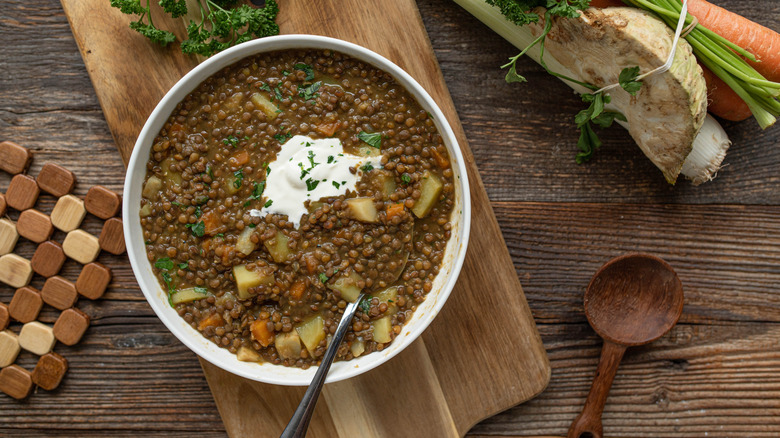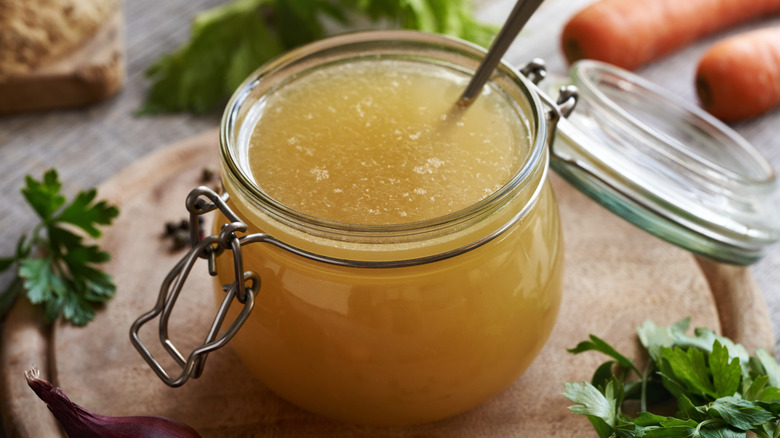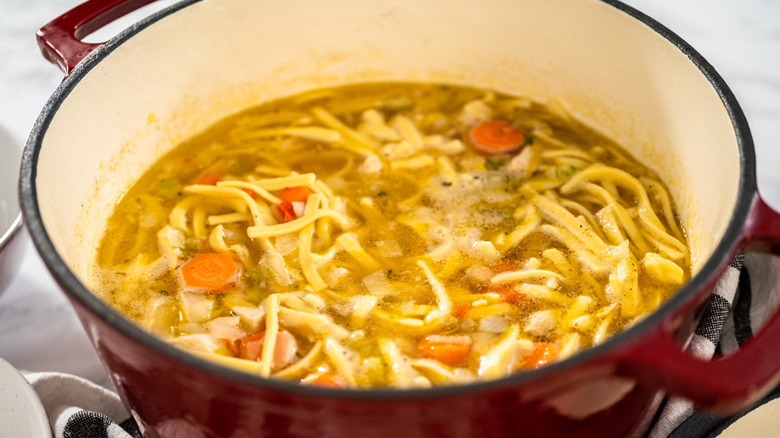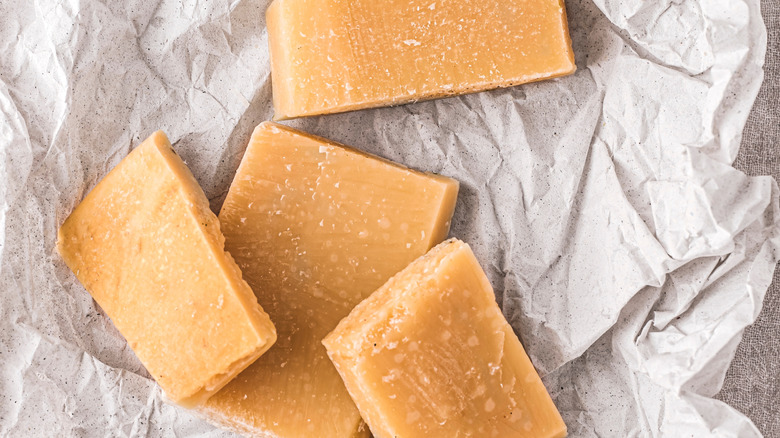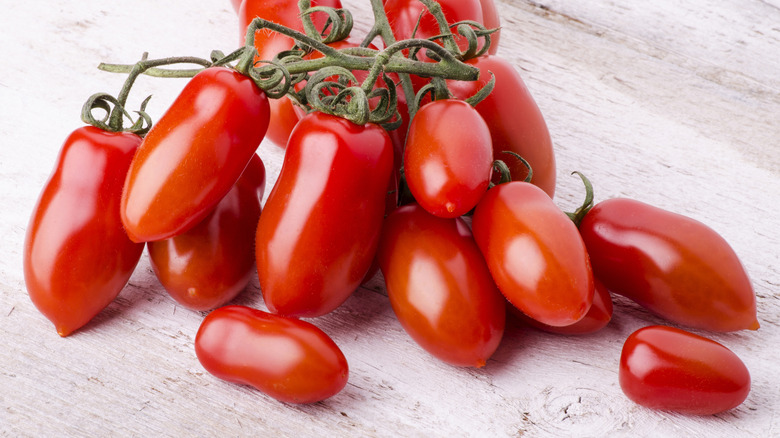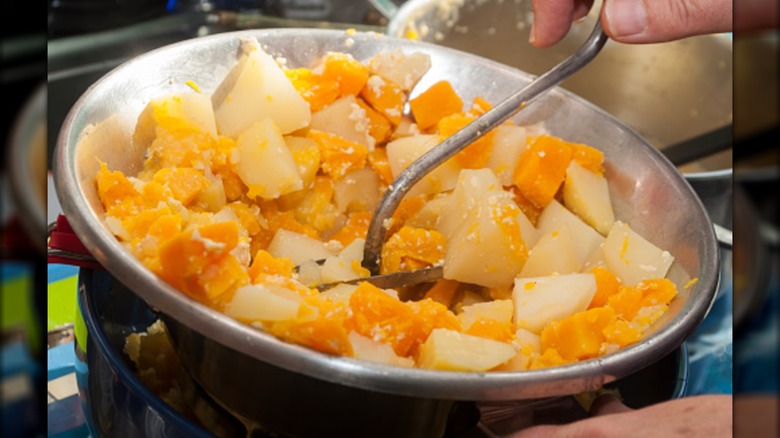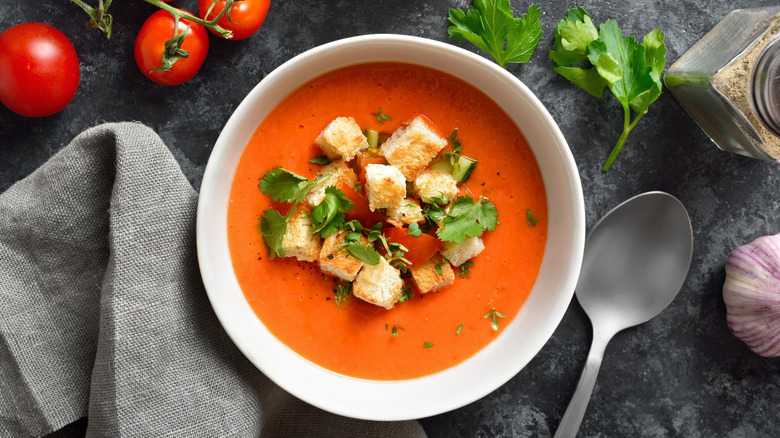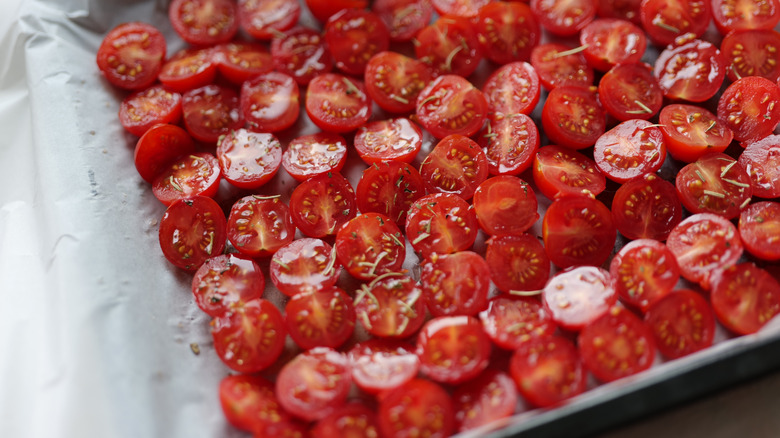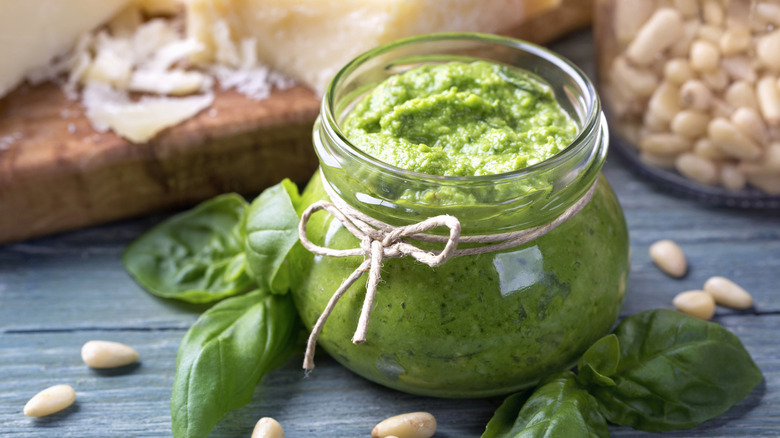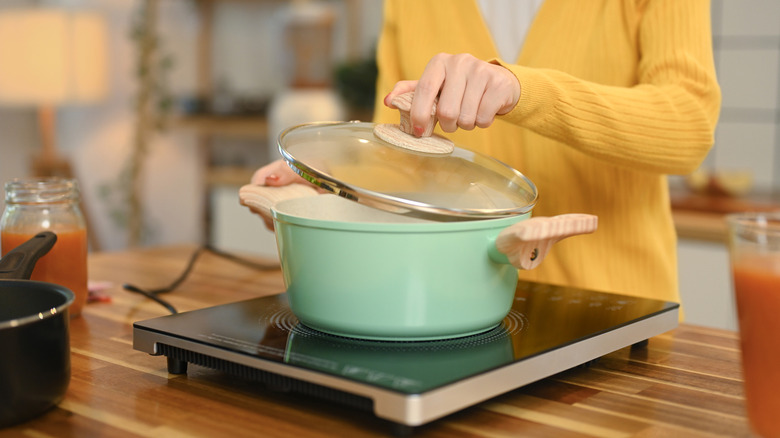Ina Garten's 14 Best Tips For Making Delicious Soup
Ina Garten. The Barefoot Contessa. Author of more than a dozen cookbooks (for which Garten tests every single recipe 25 times, just to make sure they're exactly right). Queen of "Store-bought is fine" and "How easy is that?". Who else would you trust for the best soup tips and tricks?
You may think you know your way around a good soup — and chances are that you have your own go-to soup recipes and secret ingredients or techniques for turning out a hearty stew, comforting chili, or soothing soup that your family and friends rave about. However, if you're ready to really level up your game this soup season, and maybe even expand your repertoire of soup recipes, you're going to want to take a few words of advice from Ina Garten. These are some of Garten's best tips from throughout the years, for making delicious soups.
Only use French lentils for your lentil soup
A classic lentil soup is incredibly simple, and exceptionally heart-warming and comforting during the middle of winter. So long as you have lentils and a few basic spices and pantry ingredients, you probably have everything you need already on hand. However, which lentils should you include in your soup?
Lentils come in different colors and varieties, and some types are better suited to certain tasks than others. For example, brown lentils, the most commonly available variety, sport an earthy taste and soft texture that work well when they're used in a thick soup or as a meat substitute. Hull and split brown lentils and you get red lentils, which, after they're cooked down, become super-soft. In contrast, black lentils hold their texture over a long cooking time.
When the Barefoot Contessa makes lentil soup, though, she doesn't reach for any of these. Instead, Ina Garten prefers French green lentils for soup. On the smaller side, peppery, and firm, French green lentils retain their texture even while being simmered, so they give your soup a little more of a bite. Additionally, they're excellent when used in lentil side dishes or salads.
Don't skip making your stock from scratch
Yes, yes, it's going to take some extra time. However, it's worth it. Ina Garten says to always make your soup stock from scratch if you truly want to achieve a superior flavor and texture.
If you've never made stock from scratch before, it couldn't be easier. However, the process is time-consuming and you'll need a very large stock pot and a lot of freezer space, as well as some extra storage containers. Properly outfitted, you can make your stock in quantities of up to 20 quarts, so you always have it on hand when a soup craving hits. After all, you don't want to make stock from scratch every single time you need it, no matter what Garten says.
When Garten makes her homemade chicken stock, she uses three whole chickens (remember we said you'd need a very large pot), plus a hefty amount of parsley, thyme, and dill. You'll also toss in three onions, six carrots, four celery stalks, and four parsnips, along with some garlic, salt, and pepper. It all cooks for just over four hours.
Add cheddar cheese to your corn chowder
Out of all the different types of chowder, corn chowder stands out as one of the very few that the seafood-averse among us will enjoy. In fact, it's pretty accessible to most picky eaters, relying on just basics like corn, potatoes, broth, milk, and bacon. As such, it's incredibly easy to make, too.
If you really wanted to turn this simple chowder into more of a showstopper, you could make your own broth using up leftover corn cobs, but it's hardly necessary — especially when Ina Garten's secret to upgrading a basic corn chowder is about as straightforward and convenient as it gets. All Garten does is add a bit of sharp cheddar cheese to her corn chowder recipe. She adds it in the very final minutes of the cooking time, allowing it to melt. Not only does this add flavor to the chowder, but it also helps create a succulent, creamy texture.
Invest in a Dutch oven
There are many Ina Garten soup recipes that require one staple piece of kitchen equipment: a Dutch oven. There are many good reasons for this. A Dutch oven is great for browning or braising ingredients for your soup. You can even pop it into the oven if you need to bake an ingredient (like if you're roasting some veggies or meat). Then, you can simply deglaze the Dutch oven using your broth or another liquid before adding all your soup ingredients on the stovetop, covering the pot, and letting it simmer until done. Additionally, a Dutch oven's cast iron and enamel construction expertly holds and distributes heat.
It's no secret that a quality Dutch oven is quite expensive. However, if you purchase one from a reputable brand like Le Creuset, you'll find it's a piece of cookware that lasts for years.
Toss in a parmesan rind
Want to give a soup a bit of a umami boost? Ina Garten has the perfect secret: Toss in a parmesan rind. Not the actual parmesan, but just the leftover rind. All you have to do is place it in the soup once you start to let it simmer and then leave it. Before you serve the soup, just dispose of it like you might a bay leaf.
Adding them to soup is only one of the great ways to use up your leftover parmesan rinds, though. If you have no immediate soup needs, consider making a parmesan rind broth, which you can use in future soups, risotto, or anywhere else you might need a broth. You can even just drink it straight. Merely simmer your parmesan rind with leeks, thyme, parsley, and peppercorns, in water for a few hours. You can also place a parmesan rind in your grits, rice, or beans while they're cooking, or in a simmering pasta sauce. Again, just remove it when your dish is done cooking.
Ahead of time, make sure that you're storing your parmesan rinds appropriately, for use whenever you'll want them, later. An airtight bag in the freezer will ensure they last a few months.
For simple soup recipes, ingredient quality matters
No matter what soup you're making, no matter what secret ingredients you're utilizing, keep in mind one of Ina Garten's tips across all cooking, not just soups. Quality ingredients matter.
For example, if Garten is making a tomato soup, you can bet she's not opening up a few cans of Great Value whole tomatoes; instead, she's using San Marzano tomatoes. She's not pulling together chicken stock from some dehydrated powder that comes in a cube; she's using chicken stock she made from scratch (with three whole chickens) from the freezer.
Does it really make all the differences, you might be asking as you stare at your grocery budget? In many cases, yes. There's a reason, after all, that San Marzano tomatoes are beloved by chefs. A specific type of Italian tomatoes, authentic San Marzano tomatoes are known to be the epitome of tomato flavor, with perfectly balanced acidity and sweetness. Put side by side with a store-brand canned tomato, the store brand tastes bland in comparison.
Use a food mill for pureed soups
When you're making a smooth-textured soup, like a butternut squash soup, there's a fine line between the perfect texture and pure mush. To absolutely nail it, Ina Garten recommends picking up a food mill.
A food mill may not be a kitchen tool that you already have on hand. While very useful, they're just not as popular as blenders or food processors. Manually powered with a hand crank, food mills allow you to mash solid, soft food through a sieve. As you do, the extracted food is separated from seeds and skins. Commonly, food mills are used for mashed potatoes, apple sauce, or tomato sauce. In contrast, a food processor or a blender isn't going to remove seeds and skins for you. Additionally, because using a food processor or a blender is as easy as pushing a button, it's possible that you might over-blend or process your food, leaving you with a soup with no texture whatsoever. A food mill preserves some of that texture.
Add extra texture to pureed soup for more variety
While we're talking texture, your pureed soups need it. In cases where a food mill might not help you achieve a better texture (or if you just don't want to invest in a food mill), you can add texture to your pureed soup by adding in just a few extra, basic ingredients. For example, Ina Garten recommends adding simply cubed goat cheese, croutons, and a drizzle of good olive oil to her pureed potato fennel soup.
If you're not keen on croutons, but still agree your soup could use a little crunchy goodness, consider some other crunchy ingredients your soup could be missing. Not all veggies need to be cooked before serving them as part of a soup; add fresh vegetables like sliced radishes to your soup, for both texture and a bright note of flavor. Pickled onions or roasted chickpeas are also good picks.
Elevate canned tomatoes by pairing them with a few oven-roasted tomatoes
Maybe you're making tomato soup. Maybe you're making chili. Maybe you're making tortilla soup. Whatever soup you're cooking up, you need some canned tomatoes. Don't just throw three cans of diced tomatoes into the slow cooker or stock pot without a second, thought, though. Take a page from Ina Garten's book and elevate your canned tomatoes by pairing them with a few oven-roasted tomatoes.
This is a trick that Ina Garten uses for her roasted tomato basil soup. She uses a 28-ounce can of plum tomatoes, but then combines that with 3 pounds of fresh plum tomatoes that she roasts on her own. Following this ratio, you could mimic this tactic by adjusting your recipe to be just about half canned tomatoes and half fresh tomatoes (give or take, erring on the side of more fresh tomatoes), adding up to whatever amount of tomatoes your recipe calls for. Yes, it will take extra time to roast the fresh tomatoes, but very little effort. All you have to do is halve the tomatoes; toss them with oil, salt, and pepper; and roast them for just under an hour.
Add store-bought pesto to your minestrone
Minestrone is the elevated vegetable soup that, if you're not including it in your winter soup rotation currently, you need to. Ina Garten makes her minestrone pretty classically, with carrots and celery, tomatoes and beans, small pasta, and an array of herbs. But she shakes things up a bit toward the end of the cooking process by adding a couple of tablespoons of pesto to the soup. Not only does this add some light brightness, but also extra flavor.
While you won't see pesto in what most Americans think of as minestrone today, you will find it in authentic, regional variations of minestrone, such as Genoese minestrone. The best part? While Garten may tell you to make your chicken stock from scratch for this soup, she's actually going to let you buy the pesto from the store. Just make sure to use the open jar of pesto within three or four days, freeze it for later use, or begin adding it creatively wherever you can — such as to your breakfast eggs or roasted veg.
Add your wine at the end of your cooking
Oftentimes, when you're cooking with wine, a recipe will instruct you to add the wine somewhere around the time that you're deglazing your pan, using the wine to form a sauce and cooking it down until the alcohol dissipates. However, Ina Garten will tell you, in some instances, to add your wine to your soup last. This allows more of the wine's flavors to come through in every bite of soup.
White wine can also act as a deliciously acidic component in your soup, just like a vinegar or citrus juice. If you're just making a homemade broth, rather than soup, you can similarly add white wine to your broth as it cooks, and it will provide acidity. (Don't care for white wine? There's likely a white wine substitute for cooking already in your pantry: white wine vinegar, red wine vinegar, sherry vinegar, or rice wine vinegar.)
Make your soup in advance and freeze it
Not only can you freeze your homemade chicken broth for later use, but Ina Garten also says that you should make your soup in advance and freeze it, too. Then, all you'll need to do is reheat your soup, with minimal effort. It's the best thing for an easy comfort meal mid-week or a soup-to-the-rescue when you have the sniffles.
However, do note that not all soup recipes will hold up well to freezing. There are certain foods you should never freeze, as they just don't react well to the icy temperatures over time. For example, soups that contain rice or pasta do not freeze well, due to the starch. As such, if you're making a rice or pasta-containing soup specifically with the idea of freezing it, make all of the soup, leave out the pasta or rice, and then freeze your base. Then, when you're ready to actually heat and eat your soup, cook and add the pasta or rice at that time. Similarly, due to the starch, potato soups do not hold up well in the freezer, and end up gummy.
Repurpose your leftover soup
If you have an excess of soup, but you don't want to or can't freeze it, you can pull what Ina Garten calls a "two-fer" (via Instagram), where she makes a large batch of food and then uses the leftovers to create a brand-new dish the next day. For instance, she uses her leftover tomato and eggplant soup to make a baked pasta with tomatoes and eggplant.
Similarly, you could turn creamy soups into casseroles, with the addition of a few more ingredients. If, say, you have a creamy chicken and vegetable soup, that becomes the easy base for a chicken and rice casserole, with the addition of rice, cheese, and a crispy topping. It could also be the base for a chicken pot pie. Chili becomes the base for a Tex Mex-inspired cottage pie, when you layer on the mashed potatoes. You can also blend down certain soups, like squash or lentil soups, transforming them into a sauce to be poured over chicken, rice, mashed potatoes, egg noodles, or vegetables.
Reheat your soup low and slow
However you make your soup, if you have leftovers and you're not freezing them and don't plan on repurposing them, make sure that when you do reheat them, you do so correctly. Ina Garten says to reheat all your leftover soups slowly and, as you do, if the texture isn't to your liking, add some of that homemade chicken stock to the mix until you reach your desired thickness. If you don't have any homemade chicken stock, water is fine.
If you're specifically reheating a frozen creamy soup, you may want to take further steps, such as thawing your soup in the refrigerator before reheating. Additionally, never reheat a creamy soup in the microwave, as the intense burst of heat could cause curdling. Instead, again, low and slow is the name of the game, keeping your soup at about low to medium heat, on the stovetop. Then, to keep your soup creamy, rather than adding broth or water to improve the texture, whisk in a bit of milk or cream.

